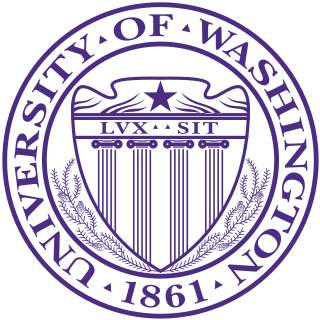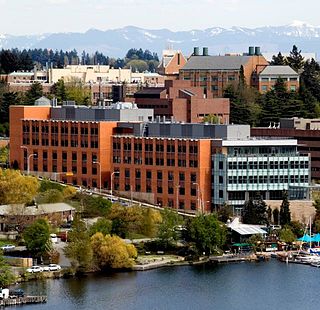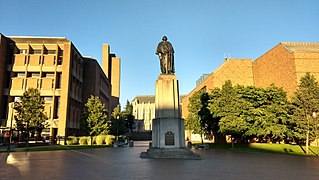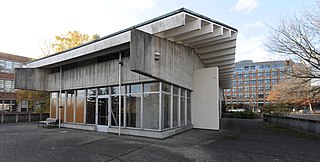
The University of Washington is a public research university in Seattle, Washington, United States. Founded in 1861, the University of Washington is one of the oldest universities on the West Coast of the United States.

The Thayer School of Engineering at Dartmouth is the engineering school of Dartmouth College, a private research university in Hanover, New Hampshire, United States.

Computer science and engineering (CSE) or Computer Science (CS) also integrated as Electrical engineering and Computer Science (EECS) in some universities, is an academic program at many universities which comprises approaches of computer science and computer engineering. There is no clear division in computing between science and engineering, just like in the field of materials science and engineering. However, some classes are historically more related to computer science, and other to computer engineering. CSE is also a term often used in Europe to translate the name of technical or engineering informatics academic programs. It is offered in both undergraduate as well postgraduate with specializations.

The J. B. Speed School of Engineering was founded in 1924 as part of the University of Louisville in the U.S. state of Kentucky with money from the James Breckenridge Speed Foundation which was created by his children William S. Speed and Olive Speed Sackett to honor J. B. Speed. Until 2003, it was known as the J. B. Speed Scientific School.
Traf-O-Data was a business partnership between Bill Gates, Paul Allen and Paul Gilbert that existed in the 1970s. The objective was to read the raw data from roadway traffic counters and create reports for traffic engineers. The company had only modest success but the experience was instrumental in the creation of Microsoft Corporation a few years later.

The College of Engineering is a division of Cornell University that was founded in 1870 as the Sibley College of Mechanical Engineering and Mechanic Arts. It is one of four private undergraduate colleges at Cornell that are not statutory colleges.

The Courant Institute of Mathematical Sciences is the mathematics research school of New York University (NYU). Founded in 1935, it is named after Richard Courant, one of the founders of the Courant Institute and also a mathematics professor at New York University from 1936 to 1972, and serves as a center for research and advanced training in computer science and mathematics. It is located on Gould Plaza next to the Stern School of Business and the economics department of the College of Arts and Science.

The Milwaukee School of Engineering (MSOE) is a private university in Milwaukee, Wisconsin, United States. Founded in 1903, the university has a primary focus on undergraduate engineering education with additional programs in business, mathematics, and nursing. Its 22-acre (8.9 ha) campus is in the East Town neighborhood of downtown Milwaukee.
The University of Washington Department of Global Health is a department jointly run by the School of Medicine and the School of Public Health at the University of Washington in Seattle, Washington. Its aim is to provide a multidisciplinary venue to address issues of global health at the university.

The Information School is the information school of the University of Washington, a public research university in Seattle, Washington. Formerly the Graduate School of Library and Information Sciences since 1984, the Information School changed its focus and name in 2001.

Henry M. "Hank" Levy is an American computer scientist. He holds the Wissner-Slivka Chair in Computer Science and Engineering at the University of Washington (U.W.).

Kalyani Government Engineering College (KGEC) is a public Engineering college in Kalyani, West Bengal. It was established in 1995 by the Government of West Bengal.
The Irwin and Joan Jacobs School of Engineering is an undergraduate and graduate-level engineering school offering BS, BA, MEng, MS, MAS and PhD degrees at the University of California, San Diego in San Diego, California. The Jacobs School of Engineering is the youngest engineering school of the nation's top ten, the largest by enrollment in the University of California system, as well as the largest engineering school on the West Coast and the ninth-largest in the country. More than thirty faculty have been named members of the National Academies. The current dean of the Jacobs School of Engineering is Albert P. Pisano.

The University of Washington Department of Bioengineering is a joint department between the College of Engineering and the School of Medicine of the University of Washington, located in Seattle, Washington.

Edward Delano "Ed" Lazowska is an American computer scientist. He is a Professor, and the Bill & Melinda Gates Chair emeritus, in the Paul G. Allen School of Computer Science & Engineering at the University of Washington.

The Campus of the University of Washington is located in the University District of Seattle. Campus buildings are categorized by the major street or vicinity on which they are located on campus. In 2011, Slate magazine and Travel + Leisure described the Seattle campus as one of the most beautiful university campuses in the United States.

Bhagalpur College of Engineering is a State Government Technical Institution established in 1960 in Bhagalpur, Bihar, India. This institute offers full-time Bachelor of Technology (B.Tech.) degree programs. It is administered by the Department of Science and Technology, Bihar. The college is affiliated with Bihar Engineering University

The More Hall Annex, formerly the Nuclear Reactor Building, was a building on the campus of the University of Washington (UW) in Seattle, Washington, United States, that once housed a functional nuclear research reactor. It was inaugurated in 1961 and shut down in 1988, operating at a peak of 100 kilowatts thermal (kWt), and was officially decommissioned in 2007.

Cornell Computing and Information Science, officially Cornell Ann S. Bowers College of Computing and Information Science and informally Cornell Bowers CIS, is the information science program at Cornell University, a private university based in Ithaca, New York.
Leilani Marie Battle is an American computer scientist. She is an assistant professor at University of Washington's Paul G. Allen School of Computer Science & Engineering. Leilani Battle is also a co-director in UW's interactive Data Lab program. She is known for her research into the visualization and analysis of complex database systems.




















